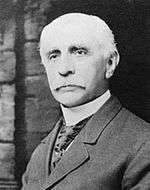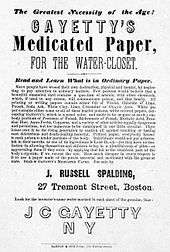Joseph Gayetty

Joseph C. Gayetty (b. 1827? Massachusetts - d.__ ) was an American inventor credited with the invention of commercial toilet paper.[1][2][3] It was the first and remained only one of the few commercial toilet papers from 1857 to 1890 remaining in common use until the invention of splinter-free toilet paper in 1935 by the Northern Tissue Company.[4][5]
Biography

United States Census records from 1860 show Gayetty lived in New York City with his family; his birthplace in the census records is listed as Massachusetts.
He first marketed toilet paper on December 8, 1857. Each sheet of pure Manila hemp paper [6] was watermarked "J C Gayetty N Y".[4] The original product contained aloe as a lubricant and was marketed as an anti-hemorrhoid medical product.[6]
Gayetty was attacked as a quack by at least one medical society.[7][8] Yet his advertisement of the same year called his product "The Greatest Necessity of the Age" and warned against the perils of using toxic inked papers on sensitive body parts.[9] A different advertisement, also printed in 1859, says his business was located at 41 Ann Street, and he was selling 1,000 sheets for one dollar.[10]
The Gayetty name and product were involved in a lawsuit that was filed in 1891, when B.T. Hoogland's Sons, toilet paper dealers, filed suit against the Gayetty Paper Company, specifically Harry K. Gayetty, for trademark infringement. B.T. Hoogland and Son's claim was that they were entitled to the use of the Gayetty name due to an unpaid debt. A paper dated December 5, 1866, was allegedly given to a creditor in lieu of $25 debt and subsequently sold to B.T. Hoogland (senior) for one dollar. However on January 1, 1866, J.C. Gayetty had entered a ten-year contract for the exclusive right to sell and vend in his name with Demas Barnes and Company, which had taken out a copyright on the product on October 27, 1891. The suit was dismissed in 1894, but another suit was brought.[11] B.T. Hoogland's Sons next sued to stop Harry K. Gayetty and the Diamond Mills Paper Company from using the Gayetty name, and in this case they were successful. Harry Gayetty appealed, but lost at the Appellate Court.[12] Finally in July 1900, the New York Supreme Court permanently enjoined the Diamond Mills Paper Company and Harry K. Gayetty from using the name on any similar paper product labels.[12]
In 1900, an advertisement shows that B.T. Hoogland's Sons of New York were distributing the watermarked "Papel Medicado De Gayetty" and giving credit to the invention of the paper in 1857 by Joseph C. Gayetty, Inventor.[13] Nearly the same advertisement was run in English in 1907.[14] The product continued to be marketed until the 1920s.
References
- ↑ David Wallechinsky; Irving Wallace (1975). The People's Almanac. Knopf Doubleday Publishing Group. ISBN 978-0-385-04186-7.
- ↑ Victor Kelley (8 March 2006). Hubris from a Not-So-Humble Hermit. AuthorHouse. p. 23. ISBN 978-1-4670-9962-2.
credited with producing the first packaged toilet paper in the U.S. in 1857
- ↑ Professor Steven Connor; Steve Connor (9 June 2011). Paraphernalia: The Curious Lives of Magical Things. Profile Books. pp. 120–. ISBN 978-1-84765-282-9.
First proprietary lavatory paper.
- 1 2 Gayetty's Medicated Paper, Cowboy Bob's Dictionary, 2013
- ↑ Quilted Northern Bath Tissue History, Georgia-Pacific, 2013 Archived March 28, 2014, at the Wayback Machine.
- 1 2 Robert Hendrickson (2000). The Facts on File Dictionary of American Regionalisms. Infobase Publishing. pp. 679–. ISBN 978-1-4381-2992-1.
- ↑ Quackery, New Orleans Medical News and Hospital Gazette, April 1859
- ↑ Richard Smyth (2012). Bum Fodder: An Absorbing History of Toilet Paper. Souvenir Press Limited. pp. 38–. ISBN 978-0-285-64120-4.
- ↑ Gayetty, J.C., The greatest necessity of the age! Gayetty's medicated paper for the water-closet. Read and learn what is in ordinary paper, An American Time Capsule: Three Centuries of Broadsides and Other Printed Ephemera, The Library of Congress American Memory, 2013
- ↑ Gayetty's Medicated Paper, the Novelty of the Day (Advertisement), New York Daily Tribune, February 3, 1859
- ↑ The American Stationer. Howard Lockwood. 1894. p. 461.
- 1 2 New England Stationer and Printer. 1901. p. 70.
- ↑ Monthly Bulletin of the International Bureau of the American Republics, International Union of American Republics. The Bureau. 1900. pp. 1–.
- ↑ Druggists Circular. The Circular. 1907. p. 7.